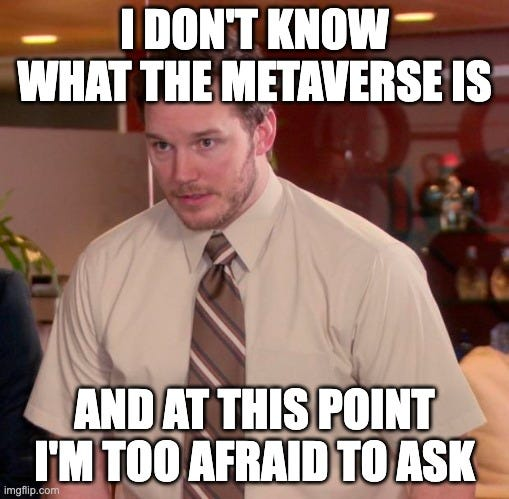 Admin | Jan 7, 2023
Admin | Jan 7, 2023
Behind the buzz: Cryptocurrency, blockchain, web3, and metaverse defined simply
Cryptocurrency, blockchain, web3, and metaverse are the buzzwords of this business generation. They’re used so frequently across an organization’s touchpoints — pitch decks, press releases, social media, and more — that it often becomes difficult to tell what the organization is exactly referring to. Most people end up feeling like this:

In the spirit of clarifying these terms, we’ve put together this simple 101 guide to define them all.
Cryptocurrency
Cryptocurrencies are digital currencies on the blockchain (discussed in the next section). It would be nearly impossible to explain cryptocurrencies without discussing the first and most known: Bitcoin. Famously created by mysterious inventor Satoshi Nakamoto in 2008, Bitcoin has taken the world by storm since its inception, now boasting well over 106 million owners across the world, compared to the estimated 320 million total users of cryptocurrency as a whole.
Bitcoin and the thousands of other cryptocurrencies that soon followed in its wake received a lot of hype. Some argued that these digital currencies would spell the end of banks, which became a symbol of financial inequality and corruption since the Occupy Wall Street movement, and even other intermediaries, such as wire transfer services like Western Union that charged high fees to overseas foreign workers remitting money to their families back home.
Despite all the hype, cryptocurrencies still have a long way to go in terms of global adoption. Their most common use case was and still is investment, owing to their wild up-and-down prices. Apart from a few crypto faithful, very few people use cryptocurrency for day-to-day transactions for a variety of reasons, which you can read more about here. Long story short, fiat isn’t going anywhere for a while.
Blockchain
Blockchain is a digital ledger that publicly records transactions. In the case of cryptocurrency, the blockchain may record the history of financial transactions between all users. Because the blockchain is immutable, people can trust its record-keeping, even though it is not backed or controlled by any central authority.
While cryptocurrency still has to make major headway, blockchain has arguably made much more traction in other industries. Because blockchain can provide record-keeping for any kind of transaction — and not just financial ones — it can be incorporated in a wide variety of use cases, including everything from retail and logistics to healthcare. Even voting has been upended by blockchain, with countries like Japan, the United States, Sierra Leone, and South Korea enabling constituents to cast votes on the digital ledger. It is this type of secondary use case, rather than the cryptocurrency one from which it first emerged, where blockchain is making greater inroads.
Metaverse
What is the metaverse? The definition of a metaverse has varied between two slight variations. Some brands refer to a metaverse as the digital universe of their own making, which users can access through augmented reality (AR) or virtual reality (VR). Facebook, for instance, bought AR-headset maker Oculus Rift as part of its bid to become the primary gateway to the metaverse. The company made this goal an overt mission rather than just another moonshot when it publicly changed its name to Meta in 2021.
Others may also use the term ‘metaverse’ to refer to a network of metaverses. No matter the definition, the metaverse has been plagued with problems. At Meta, Mark Zuckerberg laid off 11% of the organization’s workforce to continue building his metaverse, even though his own employees are apathetic about the initiative. Perhaps more shocking is the fact that Decentraland, which has achieved illustrious unicorn status with a US$1.2 billion valuation, has only 30 active users. You read that correctly: That’s 30, not 30,000.
While entrepreneurs and technologists are meant to push users forward to technologies people may not even know they initially want, it seems they have largely over-estimated the demand for people to participate in the metaverse, at least in its current incarnation.
Web3
Before we define what ‘web3’ means, let’s start with the root of it all and work our way forward.
Web1 refers to the earliest stage of the web, when webpages were primarily used to display information and were not interactive. This was characterized by a lack of connectivity and the inability of users to easily share or interact with content.
Web2, also known as the “dynamic web,” refers to the second stage of the web, which began in the late 1990s and is characterized by increased interactivity and user-generated content. Web2 technologies, such as blogs, wikis, and social media platforms, enabled users to easily share and interact with content, leading to a more participatory and collaborative online experience.
Web3, also known as the “semantic web,” refers to the third stage of the web, which as we know is still in development. The goal of Web3 is to create a more intelligent and interconnected web, where machines and software can easily understand and process data in order to provide more relevant and personalized experiences for users. Web3 technologies, such as artificial intelligence, machine learning, and blockchain, are expected to play a key role in this evolution of the web.
The “web3” meaning can thus be viewed as a contrast to web 2.0, which runs primarily on social media and a handful of tech companies that dominated the space. When discussing web3, most people are collectively referring to the technologies that may change the current incarnation of the internet, including cryptocurrency, blockchain, and the metaverse. These innovations are as much philosophically as they are technologically related: Most of these are viewed as advancing decentralization by lessening the concentration of power in companies like Google and Apple.
As much as web3 has been hailed as the future, the industry is still very much in its infancy. Part of the problem is that most of the companies are so forward-thinking that they request radical change of users that they are currently not ready to make. This is a problem we’re addressing at MetaPals, which are online virtual pets that provide digital companionship to any user who downloads the browser extension. Simply put, the fundamental concept is that you’re caring for a browser pet on any website page so long as you’re using a PC. As we develop it in the next months, these interactions will also prepare users for the future: by attending to their online virtual pets, people will also learn about and experience first-hand what the metaverse is like, including adjacent technologies like cryptocurrency and blockchain, which will drive the growth of web3. Sounds far-fetched? Well, look no further than the Tamagotchi, which arguably kickstarted the idea of an always-on, electronic device ten years before the first smartphone — and we all know how that went.
If you’re curious as to how MetaPals works, you can download the Chrome extension here.
And if you’re the sort who digs funny pet content or need the occasional chuckle from social media, you can follow our socials here.







